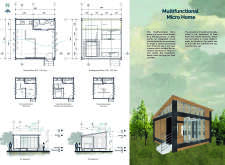5 key facts about this project
The Multifunctional Micro Home is a design that reflects the needs of modern living, particularly in urban settings. It aims to make the most of a small space by combining various functions into one cohesive environment. Inspired by the structure of microprocessors, the design promotes adaptability, allowing residents to easily alter spaces according to their activities and preferences.
Spatial Organization
The layout of the home is carefully designed to create separate zones for different activities. There are dedicated workspaces that support productivity, as well as a combination of dining and bedroom areas that encourage both social interaction and personal relaxation. In addition, a free area allows for leisure activities, offering versatility to the inhabitants. The arrangement makes it easy to shift between tasks, enhancing daily life.
Transformable Elements
An important aspect of the Micro Home is its focus on transformable elements. The architecture includes both fixed features and movable components that can be reconfigured to meet changing needs. This may involve using sliding partitions or adaptable furniture, fostering a living environment that can adjust with its occupants.
Architectural Sections
The home’s design is clarified through detailed sections that show its structural layers. The roof extends to a height of 4.00 meters, providing ample vertical space that invites natural light. Below this, the roof base measures 3.00 meters, and the ground floor is set at 0.55 meters, leading to an underground level at 0.00 meters. This layout establishes a clear hierarchy that enhances both organization and openness.
The careful design of different functional spaces, along with the potential for adjustment, results in a living solution that aligns with the realities of urban life. The combination of distinct areas within the Micro Home supports a comfortable lifestyle, where practicality and personal needs coexist harmoniously. The design offers an organized approach to daily living, ensuring that each space fulfills its purpose effectively.



















































